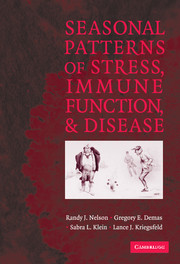Book contents
- Frontmatter
- Contents
- Acknowledgments
- Foreword
- Preface
- 1 Seasonality
- 2 Immune Function
- 3 Seasonal Fluctuations in Disease Prevalence
- 4 Seasonal Changes in Immune Function
- 5 Photoperiod, Melatonin, and Immunity
- 6 Energetics and Immune Function
- 7 Hormonal Influence on Immune Function
- 8 Clinical Significance of Seasonal Patterns of Immune Function and Disease
- References
- Index
7 - Hormonal Influence on Immune Function
Published online by Cambridge University Press: 11 November 2009
- Frontmatter
- Contents
- Acknowledgments
- Foreword
- Preface
- 1 Seasonality
- 2 Immune Function
- 3 Seasonal Fluctuations in Disease Prevalence
- 4 Seasonal Changes in Immune Function
- 5 Photoperiod, Melatonin, and Immunity
- 6 Energetics and Immune Function
- 7 Hormonal Influence on Immune Function
- 8 Clinical Significance of Seasonal Patterns of Immune Function and Disease
- References
- Index
Summary
The human body has been designed to resist an infinite number of changes and attacks brought about by its environment. The secret of good health lies in successful adjustment to changing stresses on the body.
Harry J. Johnson, 1968Introduction
Over half a century ago, Walter B. Cannon noted the ability of higher vertebrates to maintain their internal milieu within very narrow operating limits, a process termed homeostasis (Cannon 1939). This phenomenon has been appreciated for decades with regard to the internal steady-state balance of physiology and biochemistry. However, the immune system has typically been considered to be a coordinated unit that acts independently of the rest of the brain/body in response to pathogens, with the goal being to eliminate foreign factors and return to the steady-state that existed prior to the detection of the invading substances. There is now considerable evidence that both neural and endocrine factors act to maintain the immune system within “safe” operating limits (i.e., to avoid overactive immune responses that may lead to autoimmune disease or underactive immune responses that may lead to ineffective removal of foreign pathogens). There is also an abundance of evidence that suggests that the immune system acts to maintain the neural and endocrine systems within narrow operating limits.
The focus of this chapter is to evaluate endocrine–immune interactions, and to determine the extent to which these interactions contribute to seasonal patterns in immune function and disease.
- Type
- Chapter
- Information
- Seasonal Patterns of Stress, Immune Function, and Disease , pp. 190 - 217Publisher: Cambridge University PressPrint publication year: 2002
- 1
- Cited by

